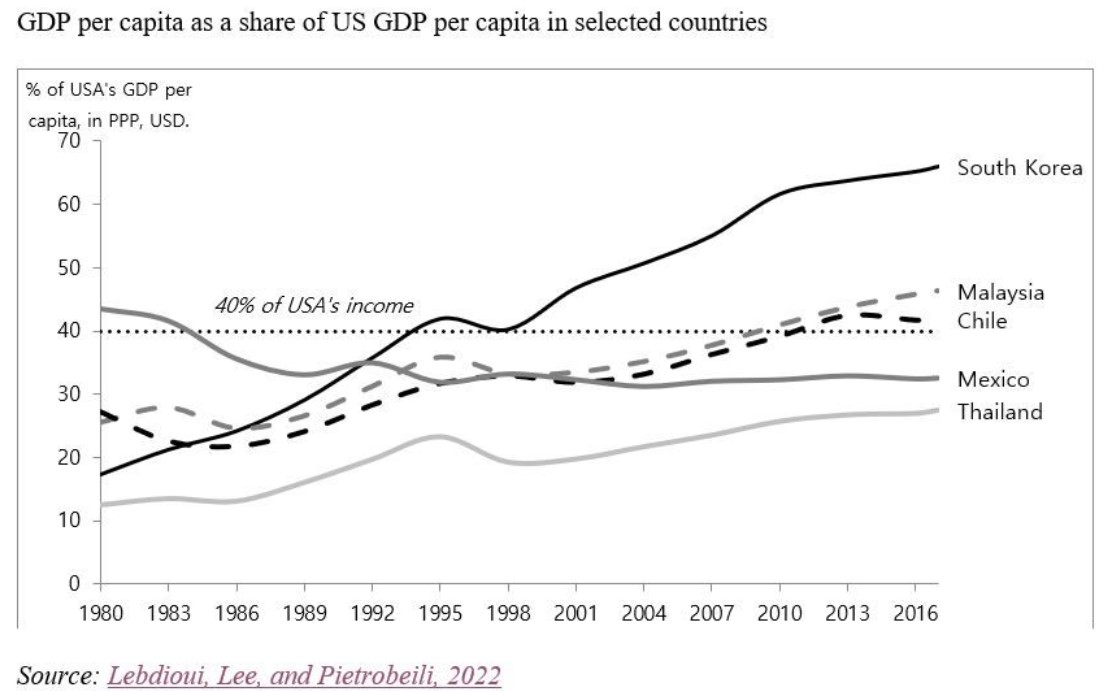
Global value chains have had some tough years. First, the COVID-19 pandemic created barriers and bottlenecks, especially in manufacturing. Then, Russia’s war in Ukraine further disrupted GVCs, particularly those involving agriculture and energy. With the fragility of globally dispersed supply networks now fully exposed, countries around the world are seeking to strengthen domestic or regional networks instead.
For developing economies, especially middle-income countries, the advent of deglobalisation poses a new challenge. After all, some of the most successful development strategies have relied on GVCs. How can economies continue to develop – and even to reach high-income status – if that strategy is no longer viable?
High-income status is notoriously difficult to achieve. The so-called middle-income trap – the growth slowdown that often sets in first – ensnares most emerging economies, with per capita income remaining at 20-40% of the level in the United States in PPP terms for several decades.
Of course, the middle-income trap does not catch everyone. Japan avoided it. So did the so-called Asian tigers: Hong Kong, Singapore, South Korea, and Taiwan. And now, Malaysia and Chile are joining their ranks, with important lessons for other developing countries navigating an increasingly deglobalised world.
In 1990, per capita income levels were lower in Malaysia and Chile than in Mexico. But, in the early 2000s, they surpassed Mexico, despite Mexico’s advantages as a member of the North American Free Trade Agreement. Since then, they have crossed the high-income threshold. Though Chile fell back below 40% of US levels during the pandemic, the World Bank still classifies Chile as a high-income economy. Malaysia remains above 40%, despite the pandemic.

This achievement might be surprising. Neither Malaysia nor Chile is renowned for its manufacturing prowess. In Malaysia, attempts to develop an automotive industry have failed, and the electronics industry has had only mixed success. Moreover, Chile was long a poster child for neoliberalism, exemplifying a policymaking orthodoxy that prevailed for decades but is now increasingly perceived as a failure.
In both countries, resource-based sectors – petroleum, rubber, and palm oil in Malaysia, and salmon, fruit, wine, and wood-based products in Chile – are the leading growth engines, catering to domestic consumers and even more to international markets. The trade surplus for Chile’s four leading export goods amounts to almost 80% of total trade in four sectors, in sharp contrast to machinery and transportation (-85%) and chemical products (-38%).
In Malaysia, the same ratio for palm oil was as high as 85%, and that of the combined resource sectors (including petroleum and rubber products) was 26%. This is significantly higher than the electronics sector (16%), machinery and transportation (-33%), and chemical products (-13%).
These are not low-value-added sectors. Malaysia exports processed palm oil, in contrast to Indonesia’s exports of unprocessed palm oil. Likewise, Chile’s salmon production requires technologies such as cold-storage systems and vaccines, and its wood-based exports include value-added products such as pulp, paper, paperboard, cork, and furniture.
These sectors are led by locally owned firms, which emerged and grew as a result of policy intervention. For example, salmon is not a native Chilean species; its cultivation in the country began in 1969, with Fundación Chile (FCH) – a nonprofit corporation dedicated to fostering business and industry growth – helping to accelerate progress since the 1980s.
Imported Norwegian technology and experiments with farming various species under different conditions were essential to making the salmon industry commercially viable. After Salmones Antartica, the company created by FCH, proved the potential, more entrepreneurs got into the salmon business. The number of salmon producers increased from around four in 1980 to more than 200 in the 2000s.
In long-colonised Malaysia, palm-oil (and rubber) plantations used to be foreign-owned. Uninterested in moving their processing facilities to the country, these owners exported unprocessed product. But, in 1981, Malaysia seized control of three British palm-oil and rubber conglomerates listed on the London Stock Exchange – a milestone in the process of decolonising its economy – and interest in local processing grew.
But upgrading the palm-oil industry was an uphill battle. The European Union imposed massive tariffs of more than 200% in the 1990s – more than double the already-high tariffs that had been introduced in the 1970s by the European Economic Community – in order to keep refining capacity in Europe.
At the same time, however, Malaysia’s palm-oil sector benefited from the rise of barter arrangements whereby the government negotiated deals to export processed palm oil in exchange for goods and services. This fueled the rapid growth of palm-oil refining within Malaysia.
As with Chile’s salmon industry, research and development was vital, and much of it has been carried out by the Palm Oil Research Institute of Malaysia, which was established in 1979, and funded by the government. These efforts enabled firms to add more value not only to palm-oil exports, but also to produce new products like biodiesel and specialty fats.
Even in the heyday of GVCs, developing and emerging economies largely had little hope of gaining enough of a foothold in high-end manufacturing sectors to propel them beyond middle-income levels. But Malaysia and Chile have shown that there is another way: Invest in developing high-value-added sectors that make the most of local resources.
Keun Lee, Vice Chair of the National Economic Advisory Council for the President of South Korea, is Distinguished Professor of Economics at Seoul National University and the author of China’s Technological Leapfrogging and Economic Catch-up: A Schumpeterian Perspective (Oxford University Press, 2022). Copyright: Project Syndicate, 2022, and published here with permission.
2 Comments
Nicely judged article. Rich countries parasitically feed off the natural resources and cheap labour of poor countries. Mexico is a classic example. Trade 'deals' and IMF 'support' are designed to look like they are offering a way out, but their real purpose is maintain the status quo .
Now look at the countries that are navigating out of this position. They have had planned state intervention, broadened (not narrowed) their exports, and attempted to move to higher value-add exports. A few have also looked at their precious raw materials (e.g. Chile with copper) and are starting to ask obvious questions about foreign control of extraction - and how they capitalise more on their assets without destroying their country.
Of course, this is a well trodden path, and historically the US and other major players have responded to developing countries exercising any self-determination by overthrowing or undermining their leaders. Chile is one to watch - their new constitution sets out a new direction, but it's socialist stance means it is already being lobbied against hard by international corporations (backed by the old guard of Chicago school economists).
Don't know that I've ever seen an article about the virtues of palm oil. I guess if clearing off all your native forests and losing all your biodiversity is progress, then Malaysia is progressing nicely.
And as for nationalising industries, perhaps that's what NZ should do. Grab all the pine forests say, most of which are owned by overseas interests.

We welcome your comments below. If you are not already registered, please register to comment.
Remember we welcome robust, respectful and insightful debate. We don't welcome abusive or defamatory comments and will de-register those repeatedly making such comments. Our current comment policy is here.